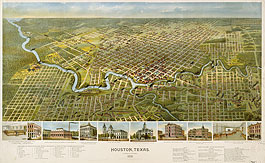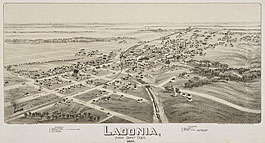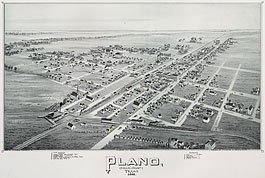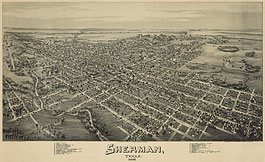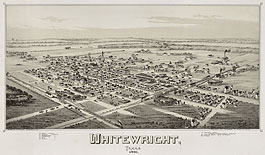Houston in 1891
A. L. Westyard’s view of Houston in 1891 documented the city as it began a decade of explosive growth—in population, growing from 27,557 in 1890 to 44,633 in 1900, as well as in area, with suburbs such as Magnolia Park appearing beyond the jurisdictional reach of the City Council but made convenient to the city center by rail transportation. Houston in the 1890s came face-to-face with the advantages and… [More]
Ladonia in 1891
The population of Ladonia, in the southeastern corner of Fannin County, numbered around 1,000 when Fowler visited in 1891 to make this view of the city. It is doubtful that there would have been a sufficient market for Fowler’s views among so few citizens themselves, in Ladonia or any of the other small towns that the bird’s-eye view artists documented. Perhaps several entrepreneurs or city officials took it upon… [More]
Plano in 1891
Plano is known today as a suburb of Dallas, completely engulfed by the larger city along with other nearby communities. But in 1891 when Fowler made this view, Plano stood separate and apart, with an economy that had begun to develop as a result of the arrival of the railroads in the previous decades. The first Anglo-American settlers in Collin County, prior to the Civil War, engaged mainly in… [More]
Sherman in 1891
The Texas Legislature established Sherman as the seat of government for Grayson County in 1846, and by 1860 the city had incorporated and become an important trading center for farmers in the surrounding area. The growth continued with the arrival of the Houston and Texas Central Railway in 1872, but because the city did not offer enough support, the Missouri, Kansas and Texas line chose to establish a new… [More]
Whitewright in 1891
Like many other Texas cities, Whitewright owes its founding to the arrival of the railroad and the westward movement of cotton production out of deep East Texas. In 1878, as the Missouri, Kansas and Texas Railroad was making its way into the state, New York investor William Whitewright purchased a tract of land in the railroad’s right-of-way. He surveyed a town site and then brought in agents to conduct… [More]











